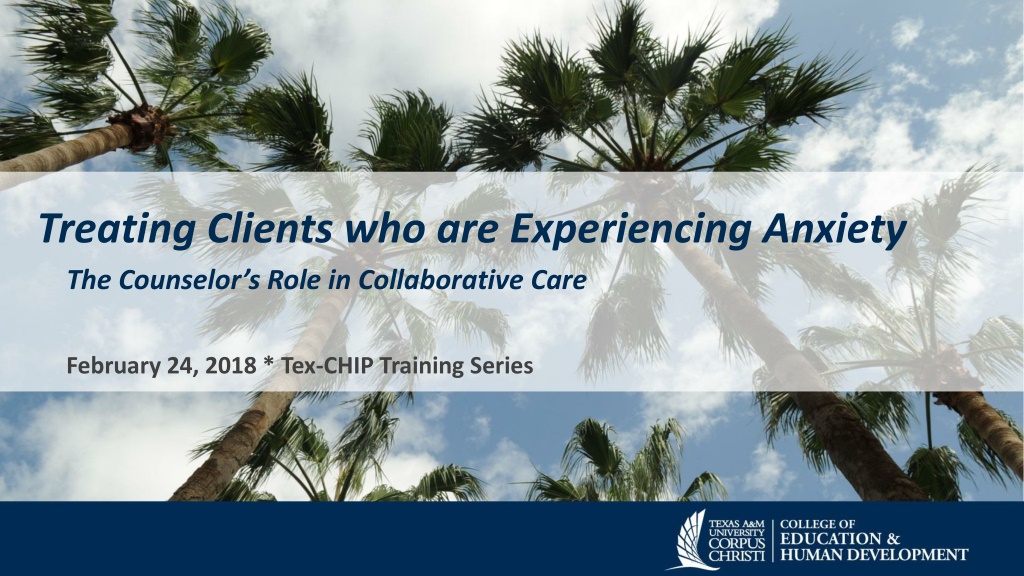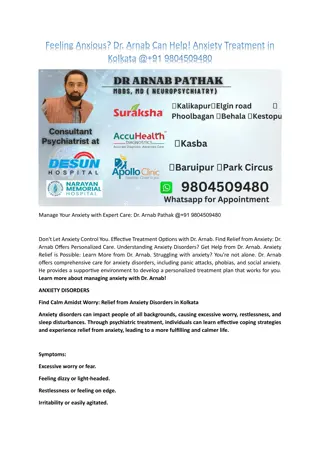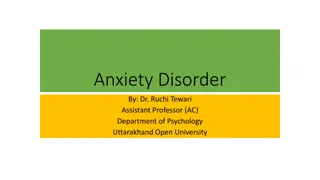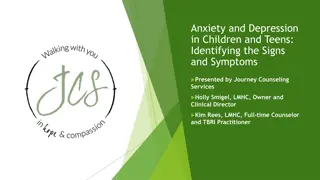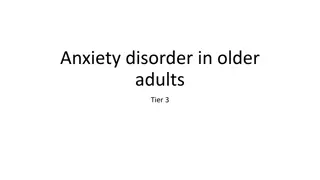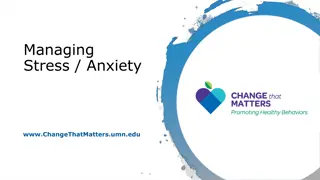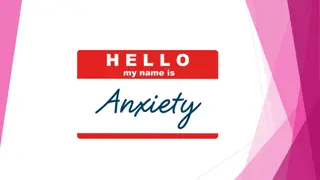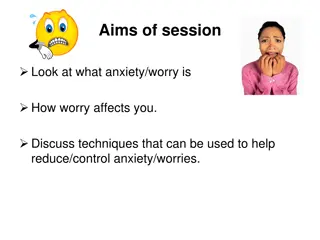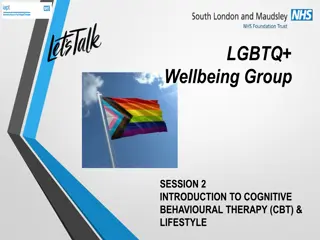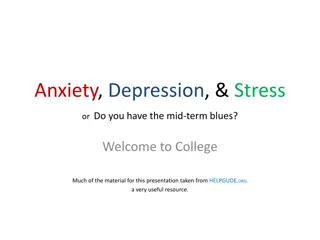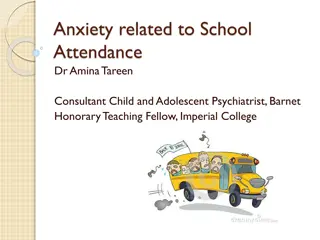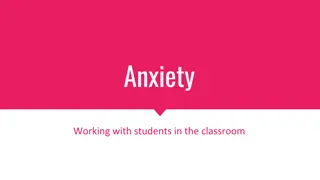Understanding Anxiety: Symptoms, Causes, Risks, and Cognitive Well-Being
Recognizing anxiety symptoms like restlessness and increased heart rate, understanding underlying causes such as trauma and stress, identifying risks like depression and social isolation, and exploring the cognitive model of well-being that influences beliefs about self and others.
Download Presentation

Please find below an Image/Link to download the presentation.
The content on the website is provided AS IS for your information and personal use only. It may not be sold, licensed, or shared on other websites without obtaining consent from the author. Download presentation by click this link. If you encounter any issues during the download, it is possible that the publisher has removed the file from their server.
E N D
Presentation Transcript
Treating Clients who are Experiencing Anxiety The Counselor s Role in Collaborative Care February 24, 2018 * Tex-CHIP Training Series
Recognizing the Symptoms Feeling nervous, restless or tense Having a sense of impending danger, panic or doom Having an increased heart rate Breathing rapidly (hyperventilation) Sweating Trembling Feeling weak or tired Trouble concentrating or thinking about anything other than the present worry Having trouble sleeping Experiencing gastrointestinal (GI) problems Having difficulty controlling worry Having the urge to avoid things that trigger anxiety
Recognizing the Causes Underlying health issues. Sometimes anxiety signs and symptoms are clue to underlying medical concern such as heart disease, diabetes, thyroid problems, respiratory problems, or tumors which produce fight or flight hormones Trauma. Children who endured abuse or trauma or witnessed traumatic events are at higher risk of developing an anxiety disorder at some point in life. Adults who experience a traumatic event also can develop anxiety disorders. Stress buildup.A big event or a buildup of smaller stressful life situations may trigger excessive anxiety for example, a death in the family, work stress or ongoing worry about finances. Personality. People with certain personality types are more prone to anxiety disorders than others are. Other mental health disorders.People with other mental health disorders, such as depression, often also have an anxiety disorder. Having blood relatives with an anxiety disorder. Anxiety disorders can run in families. Drugs or alcohol. Drug or alcohol use or abuse or withdrawal can cause or worsen anxiety. LIFE!!! Let s be honest, even the most apparently well-adapted lives are full of tension, stress, and strain
Recognizing the Risks Depression Unhelpful coping- substance use, etc. academic underperformance underemployment social skills deficits Social isolation Victimization and bullying low self-esteem Headaches & chronic pain GI problems Sleep disturbance
Cognitive Model of Well-Being Physiology, Social Environment, Personal History, and risk/mitigating factors interact in a meaningful way to influence beliefs about: Self Others The World The products of these interactions over time inform ideas about some important core beliefs suggesting degrees that we are: Lovable Capable/Competent Worthiness When factors come together in a supportive way, we develop emotionally and physically functional and adaptive rules/attitudes/schemas to inform day to day functioning. When not, we develop the attitudes and actions to approach the complexities of life that may be functional coping mechanisms, but are not adaptive.
Time to change thinking and attitudes Thoughts do not cause anxiety as a root source, but they are the treatable symptom Self-monitoring Thought tracking/mapping Positive reframing Identifying thinking traps Challenging automatic thoughts Feelings Feelings Thoughts Actions Thoughts Actions
Behavioral Conceptualizations Self-monitoring Strategic Problem Solving Relaxation training Experimenting with new skills Rewarding success Feelings Feelings Actions Thoughts Actions Thoughts
Our Treatment Plan Healthcare Domain: Behavioral Health Provider: Mental Health Counselor Goals: Interventions: Objective: Provide alleviation of presenting anxiety symptoms as indicated by client report of: (a) feeling nervous and being stressed most days, (b) fatigue, (c) difficulty concentrating, (d) sleep disturbances, and (e) experiencing occasions of tingling in extremities. a) Decreased symptom severity as indicated by a score less than 25 on anxiety symptom scale a) Educate, model, and practice cognitive copings skills using a CBT curriculum b) Educate, model, and practice engagement in cognitive and action- based coping strategies using CBT curriculum. b) Increased functioning as indicated by subjective report of anxiety-free days 5 days per week c) increased utilization of social supports and community resources as indicated by access/use of 2 supports/resources per month. c) Provide linking to supports and resources as indicated.
There is a manual for that. An 8-session approach to treating anxiety among adults
Overview of Manual Developed to reflect the practical integration of several popular CBT protocols Includes the same content within treatment identified as essential by Beck (2011) and Ellis (1994) the F.E.A.R. model (Kendall et al., 2002) was selected as an organizational framework for presenting the protocol outlined in this manual. Feeling anxious Expecting bad things to happen? Attitudes and actions that can help Rewarding skill use Each of the 8 session summaries include four component parts: 1) Purpose 2) Goals & Tasks 3) Supportive Materials for Task Completion 4) Considerations for Counselors Ethical use of supportive materials including a large white board and other materials that promote the individuation of this treatment manual to fit counselor and client characteristics is encouraged
Essential Components Psychoeducation, involving information for children and families about how anxiety can develop and be maintained, and how it can be treated Exposure tasks, which give the child the chance to be in the feared situation and have a mastery experience Somatic management, which teaches relaxation techniques Cognitive restructuring which addresses FEAR: Feeling frightened, expecting bad things, attitudes and actions that will help, and results and rewards Problem solving to generate and evaluate specific actions for dealing with problems For group sessions, 4-5 participants per group is recommended
Soft Skills are Required You are encouraged to increase treatment fidelity and compliance by integrating the motivational interviewing paradigm F: Feedback. Give your clients relevant and immediate information about their treatment and relationship to norms and standards. R: Responsibility. Clients are in charge of their change process and counselors should facilitate their sense of responsibility associated with their choices. A: Advice. Provide supportive, culturally sensitive direction to clients through education, information giving, linking and referral to resources. M: Menu. Always provide clients with a menu of treatment opportunities to choose from, but remember that each choice has an associated responsibility. E: Empathy. Conveying an empathic understanding as well as other Rogerian principles is a critical task for promoting therapeutic reinforcement and humanistic growth. S:Self-Efficacy.Communicate observation of the clients activities and attitudes that are congruent with producing the desired treatment results and/or effect. This includes communicating a general sense of optimism that the client is on the path toward recovery whether by long strides or smaller incremental changes. You also encouraged in developing rapport and promoting client change using the core foundational skills represented by the acronym OARS O: Open-ended Questions. Asking open-ended questions gathers broad, descriptive data that moves from general experience to detailed accounts and conveys to clients that the session agenda is about them and their specific progress. A: Affirmations. When sincerely provided, affirming statements validate client experiences with their problem, strengths, and change process. R: Reflective Listening. Demonstrates counselor is following the client on content and process levels of experience and is evidenced via repeating key words, rephrasing statements to promote mutual clarity, paraphrasing, and reflection of overtly expressed and implied feelings. S: Summarize. Providing summative statements to clients not only demonstrates that you have been listening and developing a working understanding of their experience, but also provides an opportunity to transition to the next session task while reinforcing what the client has said.
Process Overview Coordination with other providers to gather information Review of self-reported symptom indices Evaluation Introduction to Relationships between Situations, Feelings, and Thoughts Identifying Vulnerable Situations and Associated Feelings Identifying Negative Automatic Thoughts and Using Coping Self-talk Challenging Automatic Thoughts More Practice, More Motivation Problems Can be Solved, Choices Can be Made Relaxing into Your New Lifestyle Intervention Review self-reporting symptom indices before treatment and now Transitioning Treatment, Evaluating Treatment Gains, and Planning for Future Skill Use Transition
Activity One Explaining the Cognitive Model and Developing your Thinking Trap Lingo
Activity Two Behavioral Interventions- Strategic Problem Solving
